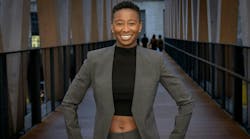Getting to Know: Architect Samantha Josaphat-Medina
When Samantha Josaphat-Medina met Luis Medina just after the stroke of midnight on New Year’s Day 2013, she knew it was the start of something special. The soon-to-be husband and wife team would become partners in both life and business, eventually opening Brooklyn-based STUDIO 397 Architecture PLLC, named for the humbling reality that she is the 397th African American female architect to achieve licensure in U.S. history.
“It is a reminder of the progress we’ve made toward equity in the profession, but also of the work that still needs to be done,” she told us about this achievement. “It sometimes feels like you are walking directly in the footsteps of pioneers.”
We sat down with her to learn a little bit more about what makes her tick, how she and Medina practice, and her best advice for those she’s continuing to pave the way for.
i+s: What makes you good at your profession and what do you find most challenging about it?
SJM: I was always able to creatively problem solve things, but it wasn’t until architecture school where I formally learned about the creative thinking process and realized that my thoughts were far more than just my imagination. But architecture can become very complicated when faced with site, budgetary and time constraints. Very often, the creativity has to reach beyond the design and into project management. This is why building a team that has the capabilities to articulate ideas in various ways (and with various types of software) is so important.
i+s: What’s your best advice for young women of color with similar dreams?
SJM: Find a mentor and learn more about their journey. Oftentimes you will learn that there are people out there that understand what you're going through even better than you. Whether you take a mentor's advice or not, it is good to have different perspectives on how to navigate through the profession.
I also always say to young aspiring architects to respect the journey and not just the end result. It's the journey that makes you; it's the journey where you learn. If I had to do anything differently, I'd probably try harder to enjoy the journey earlier.
i+s: What do you hope to achieve in the next few years?
SJM: Our goal as a practice is to work on more projects that have a hospitality focus to them, whether that is in the transportation or workplace sector.
i+s: How do you think designers and architects can integrate effective DEI principles both into their own practices/businesses as well as their projects?
SJM: The best way I believe to integrate DEI principles into your practice and business is to start off by not naming them DEI. It shouldn't be an isolated approach to things. It needs to be backed into all aspects of how one practices. The best way to have a diverse perspective is to hire, listen and support the different perspectives your office will have to offer to a client. Understanding the challenges that people from underserved communities deal with is a good way to decide the best resources to provide them and allows them to achieve the work they can do just as good as someone else who was born without that disadvantage.
i+s: How do you hope to see architecture evolve for women and women of color? What are some stigmas you see that still exist today?
SJM: The profession has been evolving but there is still room for growth. It’s one thing to provide an opportunity and another to present one that in reality is just a publicity stunt.
i+s: What’s your work-life balance like?
SJM: My work-life balance is a constant readjustment as new clients and projects come on board. Sometimes my work-life balance is consistent from week to week; sometimes it's pushing the full reset button and taking more than just the weekend off. It's also important to push work-life balance on our team so that they can remind me of what is required to be creative. Work-life balance also means keeping up my relationships with my family and friends.
i+s: What’s your favorite way to unwind?
SJM: My favorite way to unwind is taking a walk without headphones through the park during the week, and a hike when possible on the weekends. Fresh air and movement does a lot!
i+s: Who do you look up to both personally and professionally?
SJM: Personally, I look up to Ava DuVernay—a modern-day pioneer in the film industry who made this transition in her 30's. I admire it because she didn't let her fear of not knowing stop her.
Professionally I admire Zaha Hadid for being herself and bold in the industry. Lots of people change who they are about themselves to move up, and it was very apparent she was comfortable with who she was from the beginning of her rise in the industry.
i+s: How do you get inspired?
SJM: Exploring new places inspires me because I look at things that often seem typical or normal in a new light. I know when I am having a creative block it means I have been at my desk way beyond my limit.


